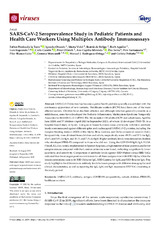Mostrar el registro sencillo del ítem
SARS-CoV-2 Seroprevalence Study in Pediatric Patients and Health Care Workers Using Multiplex Antibody Immunoassays
| dc.contributor.author | Prados de la Torre, Esther | |
| dc.contributor.author | Obando, Ignacio | |
| dc.contributor.author | Vidal, Marta | |
| dc.contributor.author | Felipe, Beatriz de | |
| dc.contributor.author | Aguilar, Ruth | |
| dc.contributor.author | Izquierdo, Luis | |
| dc.contributor.author | Carolis, Carlo | |
| dc.contributor.author | Olbrich, Peter | |
| dc.contributor.author | Capilla-Miranda, Ana | |
| dc.contributor.author | Serra, Pau | |
| dc.contributor.author | Santamaria, Pere | |
| dc.contributor.author | Blanco-Lobo, Pilar | |
| dc.contributor.author | Moncunill, Gemma | |
| dc.contributor.author | Rodríguez-Ortega, Manuel J. | |
| dc.contributor.author | Dobaño, Carlota | |
| dc.date.accessioned | 2022-09-15T11:04:38Z | |
| dc.date.available | 2022-09-15T11:04:38Z | |
| dc.date.issued | 2022 | |
| dc.identifier.uri | http://hdl.handle.net/10396/23897 | |
| dc.description.abstract | SARS-CoV-2 infection has become a global health problem specially exacerbated with the continuous appearance of new variants. Healthcare workers (HCW) have been one of the most affected sectors. Children have also been affected, and although infection generally presents as a mild disease, some have developed the Pediatric Inflammatory Multisystem Syndrome Temporally Associated with SARS-CoV-2 (PIMS-TS). We recruited 190 adults (HCW and cohabitants, April to June 2020) and 57 children (April 2020 to September 2021), of whom 12 developed PIMS-TS, in a hospital-based study in Spain. Using an in-house Luminex assay previously validated, antibody levels were measured against different spike and nucleocapsid SARS-CoV-2 proteins, including the receptor-binding domain (RBD) of the Alpha, Beta, Gamma, and Delta variants of concern (VoC). Seropositivity rates obtained from children and adults, respectively, were: 49.1% and 11% for IgG, 45.6% and 5.8% for IgA, and 35.1% and 7.3% for IgM. Higher antibody levels were detected in children who developed PIMS-TS compared to those who did not. Using the COVID-19 IgM/IgA ELISA (Vircell, S.L.) kit, widely implemented in Spanish hospitals, a high number of false positives and lower seroprevalences compared with the Luminex estimates were found, indicating a significantly lower specificity and sensitivity. Comparison of antibody levels against RBD-Wuhan versus RBD-VoCs indicated that the strongest positive correlations for all three isotypes were with RBD-Alpha, while the lowest correlations were with RBD-Delta for IgG, RBD-Gamma for IgM, and RBD-Beta for IgA. This study highlights the differences in antibody levels between groups with different demographic and clinical characteristics, as well as reporting the IgG, IgM, and IgA response to RBD VoC circulating at the study period. | es_ES |
| dc.format.mimetype | application/pdf | es_ES |
| dc.language.iso | eng | es_ES |
| dc.publisher | MDPI | es_ES |
| dc.rights | https://creativecommons.org/licenses/by/4.0/ | es_ES |
| dc.source | Viruses 14(9), 2039 (2022) | es_ES |
| dc.subject | SARS-CoV-2 | es_ES |
| dc.subject | Antibody | es_ES |
| dc.subject | Antigen | es_ES |
| dc.subject | COVID-19 | es_ES |
| dc.subject | Seropositivity | es_ES |
| dc.subject | Cohort | es_ES |
| dc.subject | Children | es_ES |
| dc.subject | PIMS-TS | es_ES |
| dc.subject | Healthcare workers | es_ES |
| dc.title | SARS-CoV-2 Seroprevalence Study in Pediatric Patients and Health Care Workers Using Multiplex Antibody Immunoassays | es_ES |
| dc.type | info:eu-repo/semantics/article | es_ES |
| dc.relation.publisherversion | https://doi.org/10.3390/v14092039 | es_ES |
| dc.relation.projectID | Junta de Andalucía. CV20-204195 | es_ES |
| dc.relation.projectID | Junta de Andalucía. PP2021 SUBMOD2.1 | es_ES |
| dc.relation.projectID | Junta de Andalucía. 1380508-R | es_ES |
| dc.relation.projectID | Gobierno de España. CEX2018-000806-S | es_ES |
| dc.rights.accessRights | info:eu-repo/semantics/openAccess | es_ES |

